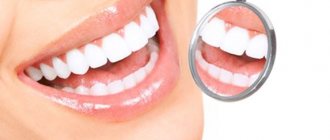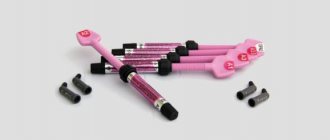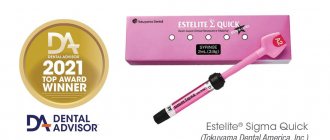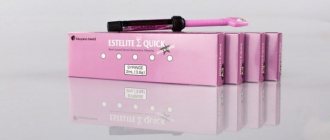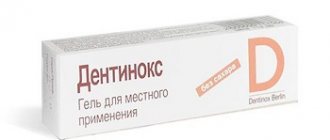Twinky Star, VOCO
Twinky Star is a light-curing compomer material for filling teeth. Available in a palette of 8 shades. Radiopaque. Manufacturer: VOCO.
Dental problems are one of the most common reasons why people go to the hospital. Some people think that children suffer from this less often, but this is actually not the case. Even baby teeth need protection and care. Their enamel is more vulnerable and susceptible to destruction more quickly, after which there is a risk of internal damage. There is a Twinkie Star product especially for such cases.
Description of the drug
Twinkie Star fillings are a dental compomer material. It has radiopaque properties and an increased light-curing effect. Other medical features of the drug include:
- The purpose of the drug is to quickly fill children's primary teeth.
- Has the effect of sparkles and light reflection.
- Polymerizes with blue and halogen-neon tints.
- Used simultaneously with dentin enamel bond.
- Manufactured using Twinky Star VOCO technology in Germany. The production is based exclusively on innovative, progressive methods and the achievements of dozens of scientists in the field of practical dentistry for children.
- The packaging of the material is selected in such a way as to facilitate the doctor’s work: it relieves the child of fear and psychological stress; ensures comfortable work with the drug, reduces the time spent on treatment.
- Has reduced abrasive effects.
- Its outer shell consists of natural fabrics that do not affect the composition in any way.
- Increased edge fitness.
- With proper use and care, Twinky Star fillings will last until a molar emerges.
- Contains an adhesive that significantly saves the doctor’s time during work and does not require conditioning.
What fillings are placed on baby teeth?
Modern medicine offers several types of fillings for children. They are selected according to the clinical case. The doctor may install composite photopolymers, glass ionomer cement, or colored fillings (compomers).
Composite photopolymers
Photopolymer (light) fillings harden in the oral cavity when exposed to a special lamp. They are distinguished by their ability to recreate the natural anatomy of the tooth. This is the most controversial material. Some dentists are of the same opinion that it is not recommended to install composite photopolymers on baby teeth due to their toxic effect on the pulp.
However, another part of dentists actively use them, considering them the most reliable long-lasting material. If the installation technology is carefully followed, they can reliably serve until the molars and incisors erupt.
Among the contraindications to the installation of light fillings are acute carious processes, insufficient hygiene and thin weakened tooth enamel.
Glass ionomer cement
Glass ionomer cement contains crushed glass (powder) and polyacrylic acid (liquid). They release fluoride compounds, which significantly strengthen tooth enamel. This is a popular material that has a number of advantages, including:
- strong connection with the structure of the baby tooth;
- high adhesion to other materials;
- biological compatibility with dental tissues;
- tight fit to the edges of the baby tooth.
It is worth noting that glass ionomer cement is sensitive to moisture and hardens more slowly compared to composite photopolymers. If the dosage is violated, its positive properties are lost.
Usually the filling remains in the tooth until it falls out naturally.
Colored fillings for children (compomers)
Multi-colored children's fillings are very popular. They are a compomer: they consist of glass ionomer cement and a hybrid composite. The chemical composition is completely safe. The main advantages of the material:
- increased resistance to damage;
- good adhesion;
- plastic;
- biocompatibility with dental tissues;
- release of fluoride (provides strengthening of dental tissue).
The use of colored fillings greatly facilitates the treatment process. Additional drilling of the molar is not required. The child himself chooses the color of the filling, so he will be interested in further oral care. Possible shades include: pink, blue, orange, yellow, green.
The risk of the filling falling out is minimized due to its strong fit. Thanks to the rich color, it is possible to control abrasion and promptly consult a dentist. Among the contraindications to the installation of colored fillings are individual intolerance to individual components of the material.
Advantages of colored fillings
But the fight against childhood fears is not the only advantage of colored fillings over ordinary ones. For example, they are durable (they last exactly as long as a baby tooth “lives” before being replaced by a permanent one).
In addition, they have a whole list of positive qualities:
- The material is highly plastic; by placing a filling in a tooth, the doctor gives it the opportunity to fill all the cracks and cracks in the tooth, after which it hardens.
- Fillings adhere well to tooth enamel, which prevents it from falling out.
- The service life of children's fillings is more than 3 years, which is more than enough for children's teeth.
- Bright colors make it possible to notice a defect in the filling and promptly consult a doctor.
- Due to the fluoride content in colored fillings, children's teeth are daily protected from caries. The filling can both give fluoride to the teeth and accumulate it from food and give it back to the milk teeth.
- They are installed only in baby teeth that will fall out. If you are worried that your child will now always walk around with a colored mouth.
- Relatively low cost of filling.
- Interesting teeth make children want to care for and brush them.
- The child reacts calmly to the upcoming visit to the dentist, the fear of dental treatment will disappear, and he will be happy to visit the dentist’s office for preventive examinations.
What are the types of colored fillings?
The rainbow colors of the fillings delight the child and help him overcome fear. Fillings come in different colors:
- Blue
- Yellow
- Greens
- Pink
- Orange
- Gold
- Silver
Boys most often choose blue, green, or purple filling colors, girls choose pink, gold or orange. But color does not affect the quality of a colored filling; no matter what color the filling is placed in your child’s mouth, it has not changed its beneficial properties and carefully performs its assigned functions.
Packaging contents and release form
The packaging includes instructions for use and the drug itself. There are currently two forms of release of the substance.
Capsules
One set contains 40 pieces, packaged in special mini-containers. The peculiarity is the variety of shades of the material: green, orange, gold, silver, blue, pink, blackberry and lemon. The package contains 5 units of each color weighing 0.25 g.
Applicators
One set contains 100 pieces of cannulas, 2 g each.
Pros and cons of Twinkie Star
Dental material has many advantages, making it ideal for treating younger patients:
- Varied, vibrant color scheme.
- Convenient and easy to use both during the installation process and while the child is wearing the filling.
- The technology for creating Twinkie Star is completely original, so it has no analogues.
- After installing the filling, a substance – fluorine – is released from the Twinky Star material for a long period of time. It has a beneficial effect on the tooth and its root system.
- Biocompatibility during the filling procedure eliminates the need for additional sealing pads.
- Shrinkage takes a minimum amount of time due to hardening in two stages.
- The finished, solid filling retains its color and elasticity for a long time.
The only disadvantage of the drug is its low availability in dental clinics in Russia.
After filling a baby tooth, possible complications
If caries of primary teeth is treated poorly, complications in the form of pulpitis may develop. This occurs in a situation where the dentist violates the filling technique and a burn occurs due to insufficient cooling of the tissue.
Also, a complication may arise due to insufficient sanitation of the cavity if the dentist has not completely eliminated the remains of necrotic tissue. As a result, favorable conditions appear under the filling for the proliferation of pathogenic microorganisms and the development of infection.
In extremely rare cases, after filling, children may develop an allergic reaction to the painkiller.
The standard service life of fillings is 2-3 years
Indications for use and contraindications
The main purpose of using the Twinkie Star set is filling baby teeth. In this case, indications for use may be different:
- Caries of cavities with stages up to the 4th class of damage. The only condition is the availability of complete isolation of the tooth from liquids.
- Tooth neck defect. Then the material is used as a preparation procedure.
- Well-defined enamel erosion. For example, when wedge-shaped anomalies appear.
- Mechanical injuries to fragments of hard tissue of a child’s jaw.
Like any other medication, there are several contraindications for which it is not recommended to use the substance for filling:
- Individual allergic reaction to the components of the drug.
- When a straight or non-straight surface of the dental pulp is detected.
- The working area in the oral cavity is a place with constant physical activity.
Advantages:
- Eight bright colors with glitter effect;
- Direct and quick application from capsules;
- Excellent polishability;
- Releases fluoride;
- Based on proven VOCO compomer technologies;
- Color system made from original materials;
- Parents can more easily get their children to visit the dentist;
- High motivation for treatment in children;
- Used in combination with a self-etching adhesive system.
Preparatory steps
Before proceeding with the installation of the Twinky Star color filling, it is necessary to carry out preparatory work. The purpose of preparation is to ensure complete sterility of the oral cavity and the diseased tooth, as well as to protect healthy tissue.
Sequence of preparation steps:
- Using a special paste that does not contain fluoride compounds, clean the surface of the dental tissues.
- Isolate diseased tissue from the rest of the mouth.
- Involve the little patient in choosing the color scheme of the material.
- Cavity preparation. It is important to strictly follow the technique. It is necessary to try to preserve as much healthy, adjacent tissue as possible.
- Use a stream of water to rinse the workplace, avoiding contact with blood or oral saliva.
- Remove excess moisture with warm spot air.
- Isolation of pulp tissue is usually not required. An exception is made if the location of the pulp is atypically close.
- Apply the adhesive sequentially, layer by layer every 40 seconds. In a standard situation, it is during this time that polymerization occurs.
- Process and polish.
When the preparation is completed, you can begin the final fluoridation at the ends of the filling or fill the entire tooth with the substance.
How does the filling installation process work?
The whole point of filling, both when using regular and colored fillings, comes down to removing damaged tissues and replacing them with artificial ones. In any case, one goal is pursued - to preserve the functionality and aesthetics of a baby tooth for a longer period.
The filling process takes place in several stages:
- The area around the tooth is numbed. To do this, the doctor uses a suitable anesthetic with a precisely calculated dosage. If a child is afraid to give an injection right away, he is offered to anoint his gums with “fruit chill”.
- Then the dental cavity is thoroughly cleaned of damaged tissue. For these purposes, a drill, laser or sandblasting tools are used.
- During the treatment process, it is important to check the condition of the pulp. If it is not damaged, then disinfection is carried out. If the pulp is inflamed, a decision is made to remove it.
- After the doctor makes sure that the caries has been removed, the tooth cavity is cleaned of bacteria. At this stage, a special gasket is also installed that will protect the nerve from the applied filling material.
- Finally, the filling itself is carried out with the material of the selected color. It is applied in even layers. To make the filling hard, it is exposed to a special light. After this, polishing and grinding are carried out.
This is interesting: Tooth pulpitis - what it is, its symptoms, prevention and treatment methods with folk remedies
First meeting with the dentist
It is recommended to introduce the baby to the doctor as early as possible, explain that the doctor cares about his teeth and is ready to tell him how to care for them. If you bring a child to the dental office for the first time with already advanced caries and acute pain, then such an appointment will definitely not leave a pleasant impression. In the future, dental phobia (fear of treatment at the dentist) and a negative attitude even towards preventive measures may develop. Parents should understand that modern equipment and materials make treatment almost painless, and pleasant little things can distract and even please the child. This approach will be the key to a beautiful and healthy smile, as well as a positive attitude towards visiting the dental clinic.
What anesthesia is used?
Baby teeth, like molars, have nerves, so they can hurt. During treatment, different types of anesthesia are used (according to the depth of tissue damage). There are three types of anesthesia, including:
- applique. It is a spray or gel that reduces sensitivity only on the surface of the oral mucosa. Application anesthesia is harmless and completely safe for the child’s body. It is often resorted to before removing a moving molar. For the treatment of caries or pulpitis, topical anesthesia is not enough;
- infiltration The technique involves an injection that blocks the nerve endings of the desired area. The new generation of drugs act instantly; after 2-3 minutes the doctor begins to treat caries, pulpitis or remove a fixed molar. During manipulations, the child is not tormented by painful sensations;
- conductor. This is the most powerful type of pain relief. It affects the nerve branch of a large area. Conduction anesthesia is used in rare cases when infiltration anesthesia is not enough (for example, if it is necessary to treat several teeth at once).
In pediatric dentistry, products based on articaine hydrochloride are used as an anesthetic.
In pediatric dentistry, agents based on articaine hydrochloride are used for local anesthesia. The active substance has pronounced analgesic properties, but is non-toxic.
It rarely causes an allergic reaction and remains in the body for a short time. It is allowed to be used by children over 4 years of age.
What is the service life?
Most children's fillings are characterized by durability; they can last until the baby tooth falls out (taking into account proper and regular hygiene procedures). Standard service life is 2-3 years.
In many ways, the reliability of fixation and service life of the filling, as well as the prevention of secondary caries, depend on adhesive systems. For the treatment of primary molars and incisors, adhesive systems of 4-7 generations are most often used.
Instructions for use of the drug
Twinky Star fillings in baby teeth
Twinkie Star has simple instructions. The substance is placed in layers into the tooth cavity. The number of all layers depends on the required thickness of the filling. At this moment, do not forget about polymerization and the maximum thickness - no more than 2 mm.
During work, the following items are used: specialized caps, matrix devices of a translucent shade, wedges with increased light transmittance; for polymerization, a standard special device is used with a light ray power of at least 500 mW/cm2 for halogen and 300 mW/cm2 for LED. In order for the adaptation of the substance to dental hard tissues to take place efficiently, it is necessary to position the end of the Twinkie Star filling extremely close to the surface of the work area. If the dentist allows a gap of more than 5 mm, then the depth may be less and the polymerization process will change. Subsequently, this may happen:
- Defective (incomplete) adherence along the edges of the substance.
- Pigmentation or erosion of the filling.
- The occurrence of natural origin of bacterial pulpitis and its development.
You can proceed to processing and cleaning the finished surface only after completely removing the matrix using special disks. The final step of the work is coating the filled tooth with a fixing medical varnish.
Which ones are better?
To decide which filling is best to place on baby teeth, you should take into account their location. Photopolymer fillings are characterized by high aesthetics, so they can be used to fill teeth included in the smile area.
They are recommended to be installed if the child is able to calmly tolerate tooth cleaning (treatment) and is not afraid of subsequent manipulations by the dentist.
Colored fillings are in great demand due to the fact that they are interesting to children and provide psychological comfort. For parents, their advantage is that by the change in shade they understand that it is time to visit the dental office.
Precautions and Tips
Despite the fact that Twinky Star material cannot cause serious harm, the doctor must still be careful when working with it. The main thing to remember is a few features:
- The substance does not tolerate contact with elements: eugenol, clove oil, which is found in many cement mortars. Their symbiosis will disrupt the polymerization of the material and reduce the quality of the result.
- Before starting work, make sure that the little patient does not have an individual intolerance to the components of the temporary filling.
- One of the properties of Twinkies is polymers that have a color reflection effect. However, this is not the result of light reflection from metals. This effect is obtained using the presence of mica. It has the property of not dissolving in a liquid medium and maintaining a low level of toxicity, which ensures an almost zero risk of allergic manifestations in younger patients.
Caring for fillings on baby teeth
After installing a colored filling on a baby tooth, you need to follow some of the doctor’s recommendations. This will help the material harden properly and serve its little owner longer. It is also important to tell your child what not to do so as not to damage the filling.
General recommendations for caring for fillings include the following:
- In the first days after filling, you should avoid eating cold or hot food or drinks. It can negatively affect the binding of dental tissues and filling material, i.e., worsen adhesion;
- in the future, it is recommended to minimize the consumption of hard and sticky foods that can damage the filling itself and the tooth;
- In the first time after treatment, you need to carefully monitor the condition of the child’s oral cavity. If unpleasant symptoms appear (pain, deformation of the filling, swelling of the gums, etc.), you should immediately consult a specialist;
- The placement of your first filling should be an important signal that you need to pay more attention to your oral hygiene. It is important to teach your child how to brush their teeth correctly, tell them about the need to rinse their mouth after eating, and you should also consult with your dentist about choosing the right toothpaste;
- Although the filling material is highly durable, it is still susceptible to the negative effects produced by sour and sweet foods. Therefore, it is recommended to reduce their amount in the child’s diet, but vegetables and protein foods should be added to the menu;
- After fillings are installed, it is recommended to visit a pediatric dentist approximately once every 3 months to monitor the condition of the filled teeth and promptly identify possible defects.
Sources:
- https://youstom.com/detskaya-stomatologiya/plombirovanie-molochnyh-zubov.html
- https://ChildAge.ru/zdorove/zdorove-rebenka/detskaya-stomatologiya/tsvetnyie-plombyi-dlya-detey.html
- https://zubodont.ru/twinky-star/
- https://www.vash-dentist.ru/lechenie/zubyi/plombyi/tsvetnyie-twinky-star.html
- https://martinka.ru/dopolnitelnye-uslugi/tsvetnye-plomby-dlya-detey/
Price
This filling procedure will not be cheap. One set of Twinkie Star filling material of 40 capsules costs approximately 7,600 rubles. For the entire process: first examination, diagnosis of treatment and placement of the filling itself - 2000 rubles. If you do not buy the entire kit, but only the materials spent on one tooth, and without the dentist’s work, you will approximately need to pay the patient’s parents the price of a Twinkie Star - from 700 to 1000 rubles.
Children, like many adults, do not like dental clinics. The sharp smell and sound of drilling frighten them greatly. Twinkie Star helped get rid of the main fears of young patients due to their participation in the process. In addition, from an early age, a child develops the habit of being attentive and caring about his health in general and the oral cavity in particular. The substance makes the dentist’s work easier: it hardens faster, does not require additional insulating gasket, excellent light reflection and other useful properties of the material.
Characteristics
Since the drug was developed for use in children, the requirements for the quality characteristics of the product are quite strict. Moreover, the development fully complies with all indicators declared by the manufacturer.
The composition is characterized by low abrasive properties, it combines well with natural tissue fragments surrounding it, and has high marginal adaptation.
The filling will not only retain its original appearance, color and shine for a long time, but will also serve the little patient until the moment when the temporary organ is replaced by a permanent unit.
Since children are unable to sit in the dentist’s chair for a long time, the doctor must do everything not only efficiently, but also as quickly as possible. The adhesive used in the etching process requires minimal time and does not require subsequent conditioning.
The convenient packaging of the drug, which allows you to apply the composition directly to the cavity area, will additionally reduce the time for placing a filling.
